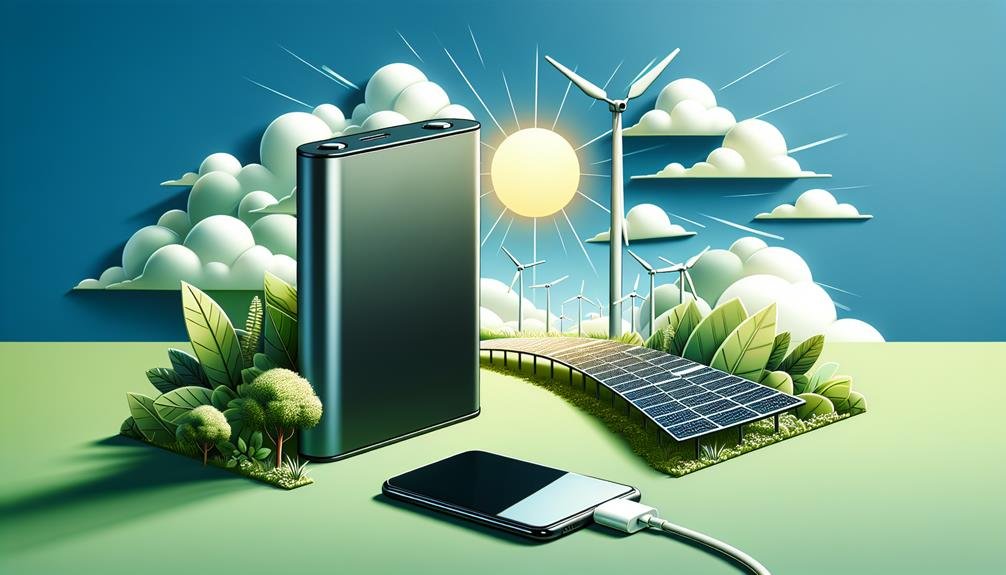Solar power banks are effective for outdoor activities, travel, and emergencies. They convert sunlight into electrical energy via photovoltaic cells, boasting efficiency rates over 20%. High-capacity models, ranging up to 25,000mAh, guarantee your devices stay charged. Look for features like rugged design, water resistance (e.g., IP65 ratings), and overcharge protection for durability and safety. However, their performance can be inconsistent due to weather dependency and variable solar irradiance. Charging speeds are slower compared to traditional power sources. Evaluating these factors will help you understand their reliability and practicality further.
How Solar Power Banks Work
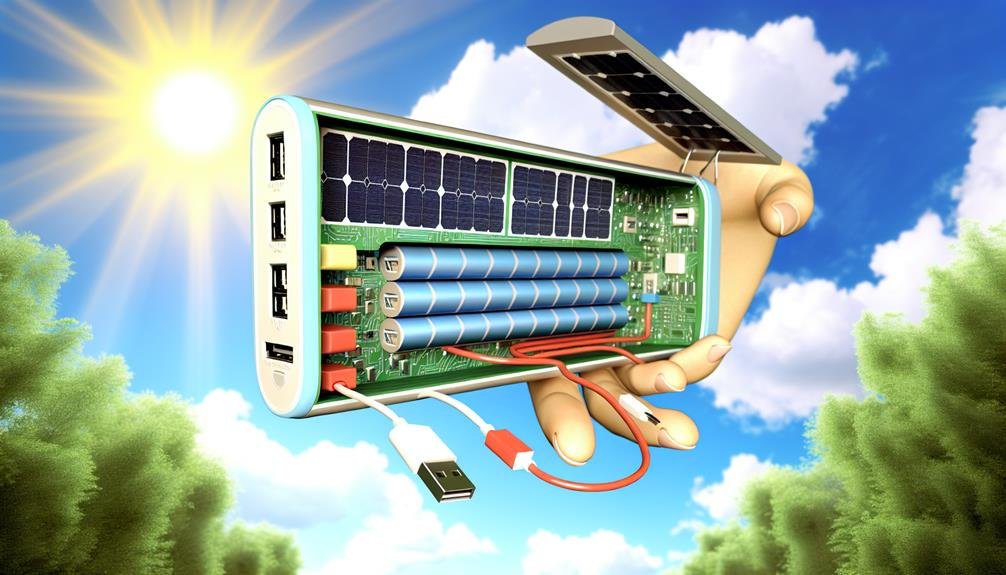
Solar power banks transform sunlight into electrical power through photovoltaic cells, enabling you to store and utilize power on the move. These photovoltaic cells are engineered to absorb sunlight and convert it into direct current (DC) electricity. The effectiveness of this process, referred to as solar power efficiency, is essential. Greater efficiency results in more energy being converted from sunlight, enhancing the functionality of your solar power bank.
When choosing a solar power bank, it's vital to consider the conversion rate of the cells. Contemporary photovoltaic cells can achieve efficiencies ranging from 15% to 22%. In practical terms, higher efficiency guarantees that even on overcast days or in suboptimal conditions, your power bank will still produce adequate power.
Battery lifespan is another significant factor. The stored energy is typically stored in lithium-ion or lithium-polymer batteries, recognized for their dependability and safety. A well-maintained battery can withstand 500 to 1,000 charge cycles, equating to several years of operation. It is noteworthy that battery lifespan can be impacted by extreme temperatures and overcharging. Ensuring the battery management system (BMS) is strong will assist you in upholding safety and extending the lifespan of your solar power bank, rendering it a trustworthy energy source.
Key Features to Consider
When evaluating solar power banks, it's important to assess key features such as charging speed, portability, and durability to guarantee peak performance and reliability. Start by examining the solar panel efficiency, which measures how effectively the device converts sunlight into electrical energy. Higher efficiency panels can generate more power in less time, essential for quick, reliable charging.
Battery storage capacity is another crucial factor. You'll want a power bank with ample capacity to store sufficient energy for your needs. A higher milliamp-hour (mAh) rating means more stored power, ensuring your devices remain operational longer.
Consider these key features:
- Charging Speed: Faster charging speeds are important, especially in emergencies. Look for power banks with high output ratings (measured in watts or amps) and fast-charging technology.
- Portability: A lightweight and compact design enhances ease of transport. Foldable panels can be a plus for backpacking or travel.
- Durability: Rugged construction with water and dust resistance ensures longevity. Check for certifications like IP67 or IP68 ratings to guarantee safety in various environments.
Benefits of Solar Power Banks
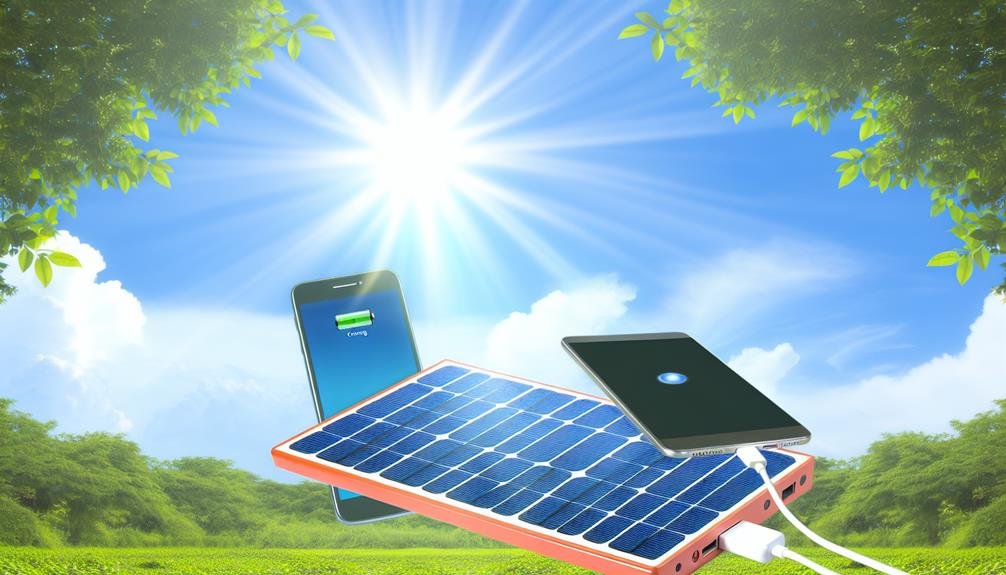
One of the primary benefits of solar power banks is their ability to harness renewable energy, making them an eco-friendly and cost-effective solution for keeping your devices charged while off-grid. By converting sunlight into electrical energy, solar power banks significantly decrease their environmental impact compared to traditional power sources. This shift to renewable energy not only conserves finite resources but also minimizes carbon emissions.
From an efficiency comparison perspective, modern solar power banks have made substantial advancements. They now boast higher conversion rates, often exceeding 20%, which means they can generate more power in less time. This efficiency ensures that you'll have reliable access to power, even on cloudy days.
When considering longevity and cost-effectiveness analysis, solar power banks stand out. They typically have robust designs, built to withstand harsh environmental conditions, thereby extending their operational life. Although the initial investment might be higher, the long-term savings on energy costs make them a financially sound choice.
In terms of safety, solar power banks are designed with multiple protective features, such as overcharge and short-circuit protection. This guarantees that your devices remain secure while charging, offering peace of mind for users concerned with both safety and sustainability.
Limitations and Challenges
You'll encounter several limitations with solar power banks, including slower charging speeds compared to traditional power sources. They're also highly dependent on weather conditions, which can notably affect efficiency and reliability. Additionally, there's a trade-off between portability and capacity, as larger batteries are less convenient to carry.
Charging Speed Constraints
Charging speed limitations in solar power banks primarily arise from the limited energy conversion rates of photovoltaic cells and the variability of solar irradiance. You might find that these factors greatly impact charging efficiency, making it challenging to rely solely on solar power for quick recharges. Here's why:
- Photovoltaic Efficiency: Most photovoltaic cells have an efficiency rate of 15-20%, meaning only a fraction of the solar energy is converted into electrical energy.
- Solar Irradiance Variability: The amount of solar energy available can fluctuate due to factors like time of day, angle of sunlight, and shading, further reducing the potential charging speed.
- Battery Longevity: Overcharging or undercharging due to inconsistent energy input can degrade the battery, potentially shortening its lifespan.
From a technical perspective, the conversion efficiency limits how much energy you can store in the power bank within a given timeframe. For instance, a 10W solar panel in ideal conditions might produce only 1.5W to 2W of usable energy. This inefficiency can be a bottleneck, especially if you need a rapid recharge. Additionally, maintaining battery longevity is essential, as inconsistent charging cycles can lead to premature wear, posing safety risks. Understanding these constraints helps you manage expectations and ensures you make informed decisions about using solar power banks.
Weather Dependency Issues
Despite the technical challenges of charging speed, weather dependency poses an even more significant obstacle for solar power banks, as inconsistent sunlight directly impacts their reliability. If you're relying on a solar power bank in regions prone to cloudy days or frequent rain, you'll find that the impact of weather on charging efficiency can be substantial. For instance, a solar panel that operates at 100% efficiency under full sunlight can drop to below 20% efficiency in overcast conditions.
To mitigate these obstacles, consider integrating backup options into your power management strategy. Utilizing a solar power bank with an in-built battery that can store excess energy generated during sunny periods can offer a buffer against cloudy days. Additionally, carrying a conventional power bank as a secondary power source ensures that you're not left without power when solar energy is scarce.
Analyzing data from weather patterns in your area can also help you better understand the reliability of a solar power bank. For those who prioritize safety, it's important to recognize that while solar power banks offer an eco-friendly solution, their efficiency is highly weather-dependent and requires careful planning to make sure continuous power availability.
Portability Versus Capacity
Balancing portability and capacity presents a significant challenge for solar power banks, as larger capacities often result in bulkier designs that compromise ease of transport. The trade-off between these factors is essential, particularly when you're on the move and require a reliable power source. High-capacity solar power banks can store more energy, but their increased weight and size can make them less portable. On the other hand, smaller, more portable models may lack the capacity needed for extended use.
To help you navigate this balance, consider:
- Portability: Smaller units are easier to carry but may require more frequent recharging.
- Efficiency: Larger panels tend to be more efficient but add to the overall bulk.
- Durability: High-capacity models often come with rugged designs, enhancing their durability but adding weight.
When appraising a solar power bank, you should evaluate your specific needs. If you're planning a short trip, a compact model might suffice. For longer adventures, a higher capacity may be worth the extra weight. Always prioritize models with robust durability features to guarantee safety and longevity. Balancing these elements effectively can make a significant difference in your overall experience.
Comparing Different Models
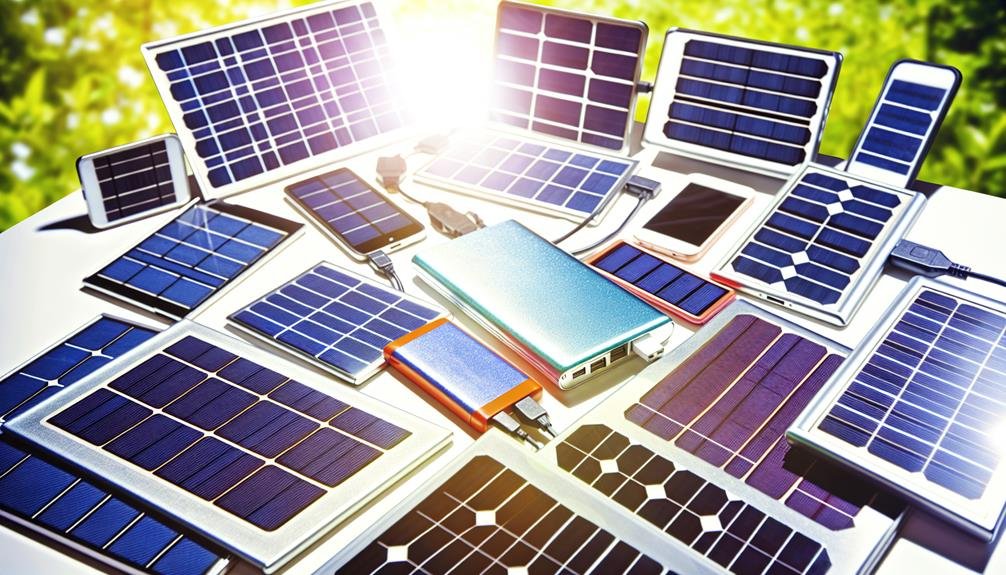
When comparing different solar power bank models, it's important to evaluate key specifications such as battery capacity, solar panel efficiency, and charging time. Battery capacity, measured in milliampere-hours (mAh), determines how much energy the power bank can store. Models range from 5,000mAh to over 25,000mAh, with higher capacities providing more charges for your devices but often at the expense of increased size and weight.
Solar panel efficiency is another critical factor. High-efficiency solar panels convert more sunlight into usable energy, reducing charging times. Look for models with monocrystalline or polycrystalline panels, as these tend to offer better performance. Charging time is influenced by both the battery capacity and solar panel efficiency. Typically, a 10,000mAh solar power bank with efficient panels might fully charge in 25-30 hours of direct sunlight.
When evaluating solar power bank durability, opt for models with rugged designs. Many high-quality units feature reinforced casing, water resistance, and dustproof ratings (e.g., IP65 or higher). Solar power bank design trends emphasize portability without sacrificing sturdiness. Some models include foldable panels or built-in LED lights for added convenience. Always prioritize models with thorough safety features, such as overcharge protection, to guarantee safe and reliable operation.
Ideal Use Cases
Solar power banks are ideal for outdoor enthusiasts, remote workers, and emergency preparedness due to their ability to harness renewable energy and provide portable, reliable power. When you're out in the wilderness or on a camping trip, these devices can be a lifesaver, guaranteeing your gadgets stay charged without needing a traditional power source.
They're also perfect for:
- Travel: Whether you're exploring remote locations or simply moving between destinations, a solar power bank guarantees you have a consistent power supply.
- Outdoor activities: Engaging in activities like hiking or fishing often means being far from electrical outlets. A solar power bank guarantees your devices remain operational.
- Emergency situations: Power outages and natural disasters can strike unexpectedly. Having a solar power bank adds a layer of safety, keeping your communication devices charged when you need them most.
Data shows that the efficiency of solar power banks can vary based on the quality of the solar panels and the intensity of sunlight. However, their ability to recharge using solar energy makes them an indispensable tool for guaranteeing safety and connectivity during travel, camping, and other outdoor activities. This makes them a practical investment for anyone prioritizing preparedness and reliability.
Tips for Maximizing Efficiency
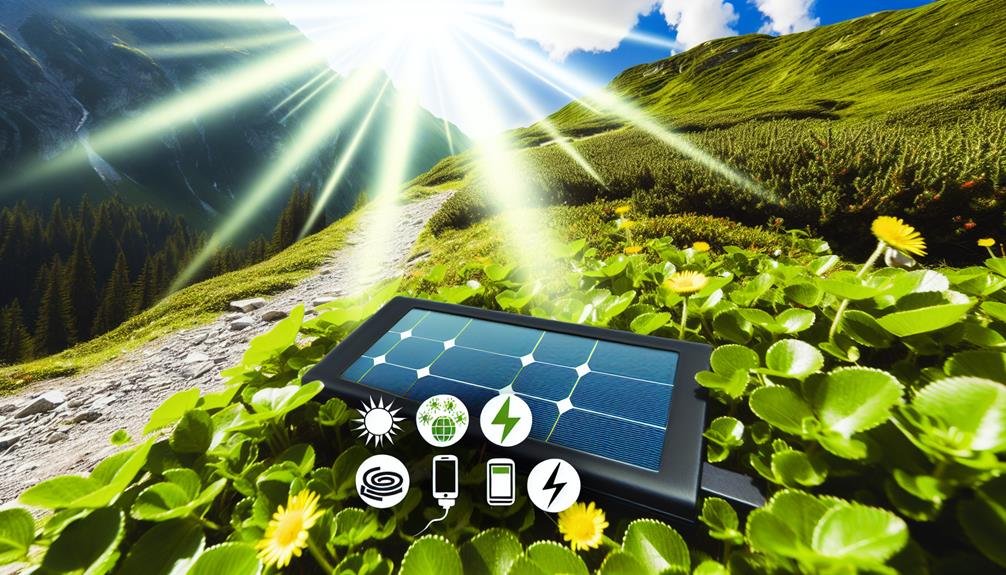
To optimize the benefits of your solar power bank, position it in direct sunlight for best energy absorption. Proper solar panel angles can greatly impact the efficiency of energy collection. Ideally, tilt the solar panel at an angle equal to your latitude for best results. For example, if your latitude is 40 degrees, set the panel at a 40-degree angle.
Battery maintenance is essential for ensuring longevity and performance. Regularly check the battery's health and avoid overcharging. Overcharging can lead to reduced battery lifespan and potential safety hazards. Make sure the power bank has overcharge protection to mitigate this risk.
Here's a quick reference table to help with key points:
| Factor | Recommended Action |
|---|---|
| Solar Panel Angles | Tilt at latitude angle |
| Direct Sunlight | Place in unobstructed sunlight |
| Battery Maintenance | Avoid overcharging |
| Overcharge Protection | Verify built-in safety features |
| Panel Cleanliness | Clean regularly for efficiency |
Moreover, keeping the solar panels clean enhances their efficiency. Dust and debris can obstruct sunlight absorption, so wipe the panels with a damp cloth periodically. Following these suggestions guarantees that your solar power bank operates at peak efficiency, providing a reliable and secure energy source.
Frequently Asked Questions
How Long Do Solar Power Banks Typically Last?
Like a reliable companion, a solar power bank's durability typically spans 500-1,000 charge cycles, depending on usage. Its charging capacity can decline over time, so monitor it closely for safety and efficiency.
Can Solar Power Banks Charge Laptops and Other Larger Devices?
Regarding laptop compatibility, solar power banks can charge laptops, but charging speed varies. Confirm the power bank's battery capacity is sufficient and check for proper ports. Portability might be affected due to larger battery requirements for laptops.
Are Solar Power Banks Safe to Use in Extreme Weather Conditions?
Have you considered solar power bank durability in extreme weather conditions? They're generally safe, built to withstand harsh environments with water and dust resistance ratings. However, always check specific product specifications for best extreme weather safety.
Do Solar Power Banks Require Any Special Maintenance?
You'll need to follow cleaning tips like wiping panels with a damp cloth. To maximize battery lifespan, avoid overcharging and use waterproofing techniques. Regular inspections guarantee safety and efficiency, especially in extreme weather conditions.
How Eco-Friendly Are Solar Power Banks Compared to Traditional Power Banks?
Imagine a greener footprint. Solar power banks, because of their energy efficiency and sustainability, tend to have a lower environmental impact and carbon footprint compared to traditional ones. They're a safer, eco-conscious choice for tech-savvy users.

